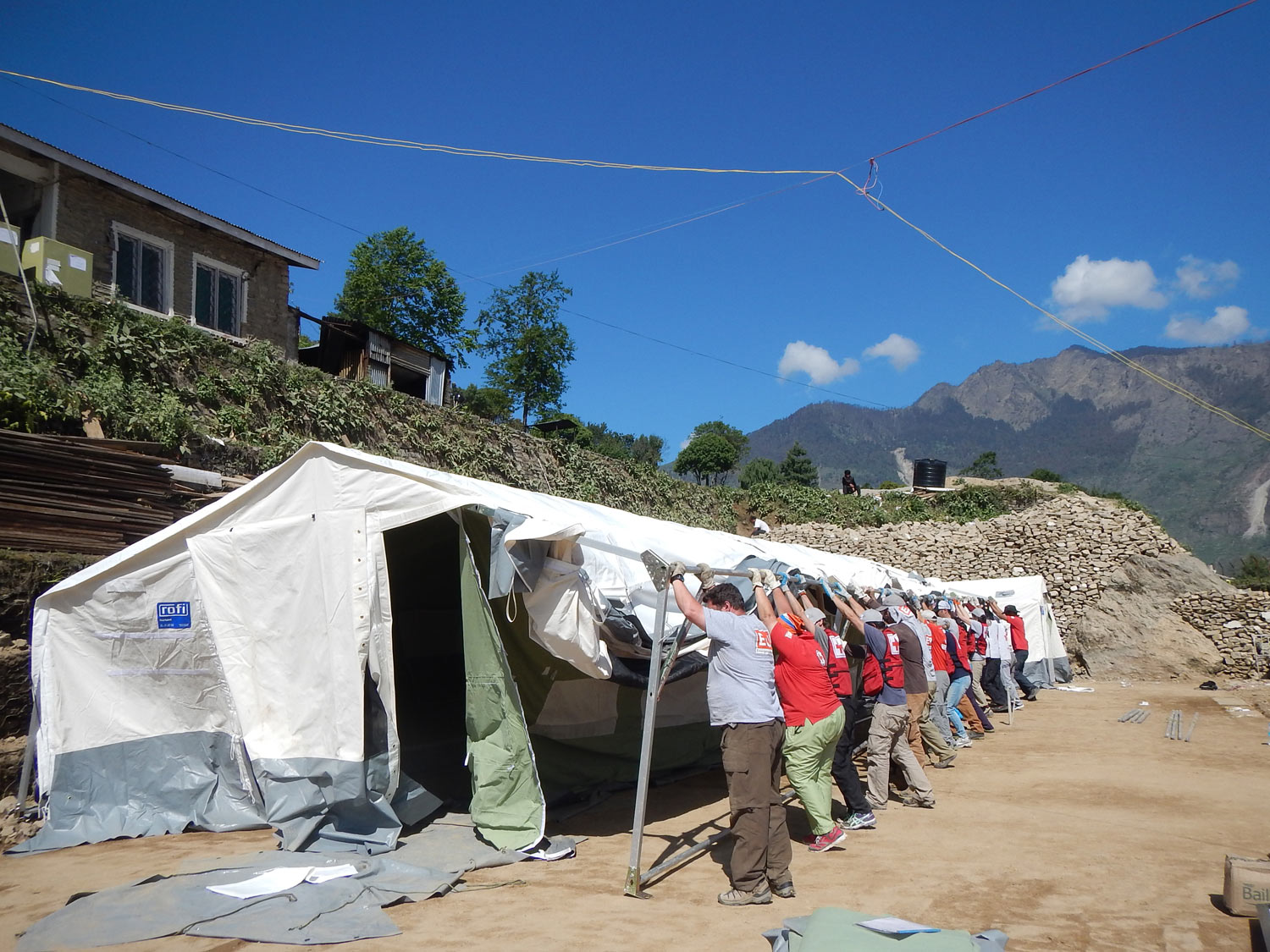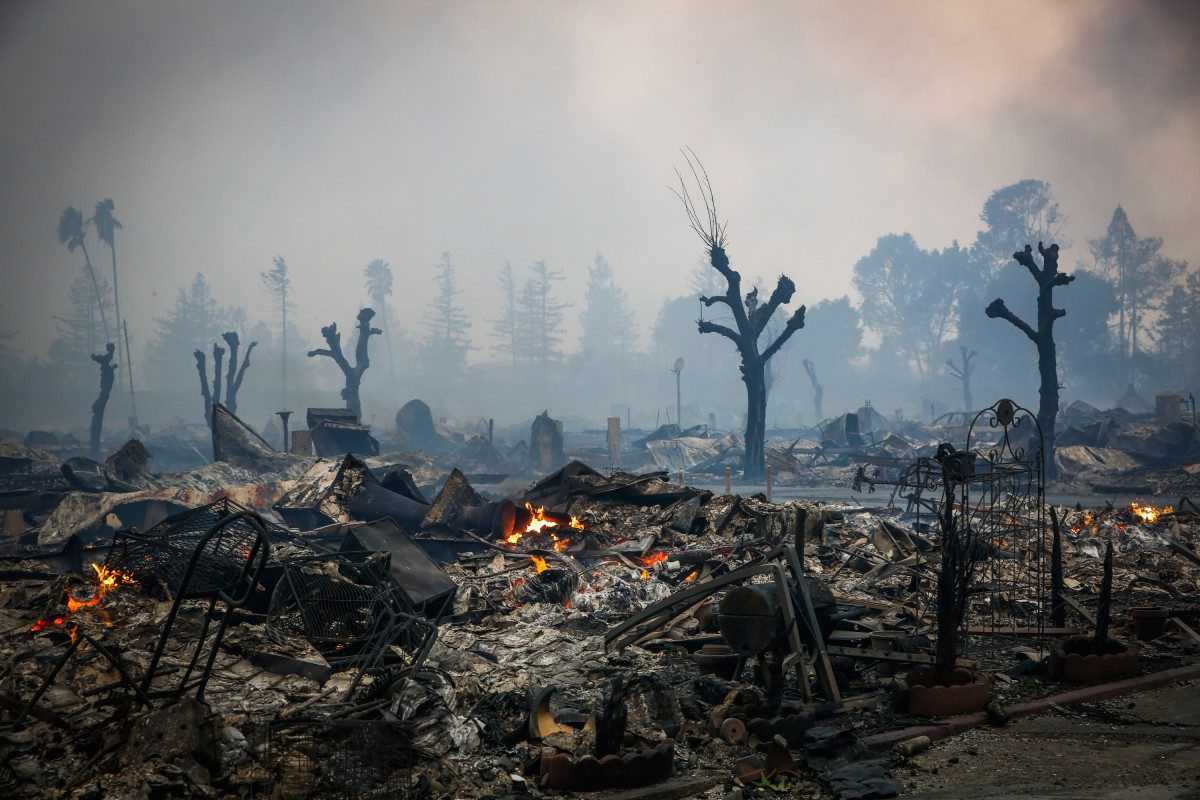This story starts with a bang. Multiple bangs actually. In the middle of the night, when they are least welcome.
Rob Koslowsky [BSc(EE)/81], sleeping on the second floor of his Santa Rosa, Calif., home, hears them but in his slumber he’s unable to form their meaning. Why are the garbage can lids rattling so loudly in the wind?
Then there is commotion. Movement in the house. Voices. By the time his eyes open and his brain assesses the situation, he realizes that the disruptive noise is someone frantically banging on the front door. Something is wrong.
It’s the police. An officer enters the house. The beam from his flashlight cuts wildly through the blackness of the power outage that hit earlier in the evening. He’s ordering everyone out. Koslowsky’s wife Yvonne and daughter Lindsay are already moving, scrambling to get dressed and gather their belongings. But there is no time. The policeman is firm: This is an emergency evacuation. Leave everything and get out.
Koslowsky, a 58-year-old electrical-engineer-turned-marketing consultant, dressed only in his pyjama bottoms, reaches for a polo shirt at the foot of the bed. The officer sticks close, hurrying him along. There is no debate. No discussion. Any thoughts of grabbing other essentials, such as medications or passports, are dashed by the officer’s insistence. Now out into the night, moving towards the family Volvo parked in the driveway, it becomes clear what the danger is. The air is thick with smoke, and the strong California wind—appropriately called the Diablo—is blowing black dense fog through the normally peaceful culde- sac. The wildfire is close. Moments away.
As the officers move on to neighbouring houses to rouse others to safety, Koslowsky hesitates. He’s forgotten something. With a mumbled “I’ll be right back,” he returns to the house to lock the front door.
Weeks later, standing over the pile of debris and ash where his home once stood, Koslowsky would realize how utterly futile that last act was.
The Tubbs fire (named after the location where it ignited) is considered the worst in California’s history. In its deadly wake, it left more than 36,000 acres scorched and 5,600 buildings razed in the Napa and Sonoma counties. Twenty-two people lost their lives.
The city of Santa Rosa bore the brunt of the losses, with more than 2,800 buildings destroyed—including the Koslowskys’ home.
“How do you plan for, respond to, or recover from, something that has exceeded what you’ve been able to imagine or what you’ve been able to prepare for?”
“They said the Tubbs fire traveled at three miles an hour, which doesn’t sound fast, but it essentially means it was burning an acre a minute,” says Koslowsky. “And because of the winds, it was spewing burning embers a half mile ahead of the fire front. The embers were projectiles getting embedded into houses and igniting them. The fire was even jumping the freeway, which is unheard of.”
In the U.S., there were 16 weather and climate disaster events with losses exceeding $1 billion each in 2017—a record year. Add to that the rest of the globe’s headline-grabbing floods, tsunamis, monsoons and earthquakes, not to mention man-made disasters and terrorism attacks. In a world of instant communication they feel more constant than ever.
Koslowsky says, “I’ve stopped watching the news. For therapeutic reasons.”
THE SCENE
Although researchers have been studying disasters in their own fields for over a half century, disaster science began to emerge as its own, defined discipline only within the last decade or so. The University of Delaware’s Disaster Research Center (DRC)—of which Tricia Wachtendorf [BA(Adv)/96] is co-director—pioneered what’s known as quick response research. This methodology requires academics beeline it to disaster zones, sometimes within hours, to collect “perishable” data as events unfold, and before memories fade.
“How do you plan for, respond to, or recover from, something that has exceeded what you’ve been able to imagine or what you’ve been able to prepare for? That’s what we’re trying to understand,” says Wachtendorf.
On Sept. 13, 2001, with the collapsed World Trade Centre towers still smouldering and a populace still in shock, Wachtendorf touched down in New York City with a job to do. She and her colleagues got up close to those living and breathing the disaster as it happened. They studied the reactions of emergency responders, disaster recovery workers and, of course, survivors.
A key finding—that has since influenced disaster management not only south of the border but abroad—was just how important improvisation is when dealing with the unforeseen. Wachtendorf points to how a fleet of mostly civilian boats, with no centralized coordination, worked together to evacuate 500,000 people from Manhattan in the immediate aftermath of the terrorist attack. The heroic effort is documented in the book she co-authored, American Dunkirk: The Waterborne Evacuation of Manhattan on 9/11.
These observations shifted organized responses away from being overly rigid to being something more flexible. The message is clear: Chaos calls for creativity. “Planning and management systems are necessary but shouldn’t stifle the emergence and creativity of groups that end up actually being very helpful,” she says. “Planning and improvisation go hand-in-hand.”
On a cold night last January, a 7.9-magnitude earthquake struck the Gulf of Alaska, causing officials from Environment Canada and the National Tsunami Warning Center in the U.S. to issue an alert. A tsunami was coming.
Warning sirens blared in communities up and down the British Columbian and Alaskan coasts, waking residents from their slumber and activating emergency response officials to prepare for the approaching disaster.
Hours later, the alert was cancelled. But, like the ballistic missile warning that occurred in Hawaii a few weeks earlier, it was a wake-up call. How prepared are we really?
In areas like the Pacific Northwest where some experts predict the “big one”—a 9.0-magnitude earthquake that will cause 20-metre-high tsunami waves, potentially killing thousands from B.C. to northern California—has a one in three chance of happening in the next 50 years, the question is even more relevant.
“It is really difficult to be totally prepared,” John Clague, an earth sciences professor at Simon Fraser University, acknowledged to media at the time. “I would say we’re not really ready for something like this.”
Fortunately, within the dark shadow of looming disasters there is hope: the rapid growth of the emergency management field. The Bureau of Labor Statistics in the U.S. estimates the need for emergency management directors to grow by six per cent by 2024.
“Over the past 10 or 15 years there have been tremendous strides within the private sector, as well as government and non-governmental organizations, to make disaster planning part of their routine activities,” confirms Wachtendorf. “It used to be a profession where you might have people who were retired military or police acting as emergency managers. Today, we see a lot more professionalization, so there is a combination of those with experience and those with a solid knowledge of planning and management in a crisis.”
Companies are talking about the concept of business continuity—the ability to operate with minimum disruption through a disaster. “It’s a market differentiator,” says Lisa Reshaur [BA(Adv)/91], who leads critical areas of risk, continuity and digital security at Microsoft.
“I’ve seen great examples of companies that had good continuity in place that were able to prove they could continue to support their customers; they ended up taking market share away from competitors when there were major regional disasters. Their competitors were not able to respond, but they were.”
Though growth and professionalization of the emergency management sector are vital, further innovation is just as important.
“The risks and circumstances that we face have also evolved. So, it’s not something that we can just sit back and say, ‘We’re prepared,’” says Wachtendorf.
How will climate change continue to impact the scale of natural disasters? How does the threat of cyber-terrorism affect disaster response? How are disasters handled when they have broad transnational impact?
These questions engage disaster experts all over the globe, say Wachtendorf. “The disaster research and science field is at a critical crossroads where we’re continuing to assess what we need to focus on next to really move the field into the next level.”
“Any buildings still standing had pieces missing or roofs caved in.”
THE MAKE-SHIFT
Peering down on the Himalayan town of Dhunche, Nepal, from the window of an Indian military helicopter, Dr. Doug Maguire [BSc/77, MD/82] could clearly see the devastation.
The 7.9-magnitude earthquake had taken its toll on the village of approximately 2,500 people.
“Any buildings still standing had pieces missing or roofs caved in,” says the anaesthesiologist and associate professor in the Rady Faculty of Health Sciences at the University of Manitoba. “In the empty patches beside buildings where you would normally see cattle or goats, people had set up tents. They had moved out of their stone homes because they were collapsing.”

Photo by Douglas Maguire
It was April 2015 and Maguire was part of a team of 17 Canadian Red Cross volunteers deployed to set up a mobile field hospital in the wake of the devastating earthquake that killed nearly 9,000 people and injured tens of thousands more in the surrounding area.
Dhunche had the only hospital in the region. Now it lay in ruins.
“The hospital had some buildings standing, but for the most part they were unusable,” he says. “So, our first challenge was to clear the rubble to create some level ground to erect our mobile field hospital.”
Exhausting work, but Maguire says a week-long training exercise that he and the other team members received on constructing and operating the state-of-the-art Canadian Red Cross field hospital paid off.
“When you hit the ground someplace strange, it’s good to know that everybody around you has been through that level of preparation and training,” he says.
For the next four weeks, Maguire— who has made his way to volunteer on the frontlines of several disasters, including post-tsunami Sri Lanka (2004) and post-earthquake Haiti (2010)—helped deliver health services, from treating earthquakerelated injuries and wounds, to delivering babies.
As fulfilling as the humanitarian work is, Maguire says it is even more meaningful knowing that community health care continues long after he and the Canadian Red Cross head home. After a four-month run, the mobile field hospital in Dhunche was transferred to locals.
“That’s an interesting aspect of the whole Red Cross philosophy because it transforms from a disaster project into a development project, which improves the resilience of that community to handle whatever the next disaster is,” he says. “Their hospital was wiped out, but it was replaced. So there’s something there after the disaster.”
The TECHNOLOGY
While Maguire and his team were on the ground administering health care to locals in Dhunche, unmanned aerial vehicles (UAVs) were skipping across the sky throughout Nepal, surveying damage, mapping impacted areas and aiding search and rescue efforts.
“Disaster response is an area where Facebook is in a unique position to help keep our community safe.”
Though usually associated with military use, drones are becoming an increasingly important part of the disaster response and recovery toolkit, providing information to responders in real time.
In recent years, there has also been growing interest in drones being used to transport medicine and supplies to inaccessible regions. Though there is still debate about their effectiveness, a lifeguard made headlines in January when he used a drone to drop an inflatable safety device to two swimmers caught in heavy surf off the east coast of Australia. The drone was able to reach them in only 70 seconds.
UAV technology is still an emerging disaster management tool, but social media is already a staple.
That became especially clear to Wachtendorf when Mark Zuckerberg contacted the DRC and the Center’s community partners last fall to discuss the importance of social media in a disaster.

Photo by Evan Krape/University of Delaware
“Disaster response is an area where Facebook is in a unique position to help keep our community safe,” the Facebook CEO told them.
And he wasn’t just spouting hyperbole. The social platform includes tools that activate during a disaster, the most prominent being Safety Check, which automatically asks people in a disaster area if they’re safe and then immediately follows up with a notification to friends and family.
Facebook also implemented Community Help, a tool that connects volunteers who can offer food, shelter or other resources to people impacted by a disaster.
Snapchat too has shown its value in the face of disasters. During the Tubbs fire, the social channel used geo-location tagging to collate content about the blaze.
At the height of the disaster, more than 12,000 videos and images had been uploaded, helping to keep the community informed. Twitter users, meanwhile, kept up to speed by monitoring unique hashtags #santarosafire and #tubbsfire.
Although Wachtendorf recognizes the importance of social media during a disaster, especially for those who use it regularly, she warns against making assumptions that could put lives at risk.
“We have to be aware of disparities in terms of access to those platforms, and thinking about demographic issues of who’s using it,” she says. “My mother, for example, is not going to be on Facebook.”
The Rebuild
When Koslowsky sifted through the ashes of his former home, he was flooded with emotions. Relief that he and his family got away safely. Thankfulness for the emergency responders and recovery agencies. Anxiety about the next chapter of his life.
“It’s just complete and utter devastation. Our memory-filled home is in ruins,” says Koslowsky.
In the rubble, he found objects that survived the scorching heat and for him feel symbolic. There was a charred magazine page with the headline “Finding Hope After Hell,” and his soot-covered U of M engineering ring, now back from the jeweller after a cleaning.
But it’s the care his family got from those around them that means the most—those who served hot meals, put together toiletries kits, or gathered clothes in their size. “These acts of kindness allowed us to return to some level of normalcy,” he says. “We now try to rebuild our lives, our hearts filled with hope.”
TORNADO TIME
Summer on the Canadian prairies usually means tornado warnings. Stay safe with key tips from the U of M’s John Hanesiak [PhD/01], an environment and geography professor who teaches the country’s only for-credit storm-chasing course.
This extreme-weather specialist—who is fascinated by how tornadoes form and change—brings students on 6,000-kilometre tracking trips and says no two storms are the same. They brew in hot, humid air, when there’s atmospheric instability and strong vertical wind shear (an increase in velocity and/or a change in direction and altitude).
- If you see a tornado touch ground, quickly gauge where it’s headed. If it looks static, change your position. It’s either moving directly away from you—or coming right at you. “As long as you can see motion to it, you are pretty safe to stay put.”
- Don’t get too close (less than one mile) since a tornado’s direction can sometimes change erratically.
- Keep in mind: It’s a misconception that you should take cover under a bridge or overpass, where winds can be intensified. “It can actually be more dangerous doing that.”








The UofM has other significant connections to disaster research and emergency management. In the 1980’s there was an interdisciplinary disaster research group centered around Dr John Rogge in Geography. Among the students who studied disasters at that time was Dr Emdad Haque (M.A. 1982, PhD 1988) who is now a Professor with the UofM’s Natural Resources Institute. Two of his fellow students, Dr Balfour Spence (PhD 1990) and John Lindsay (B.A.hons. 1989, MCP 1993), now teach in Brandon University’s department of Applied Disaster and Emergency Studies that Dr Haque helped to create in 2001.